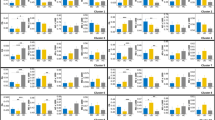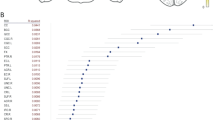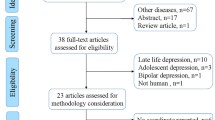Abstract
With the introduction of diffusion tensor imaging (DTI), structural differences in white matter (WM) architecture between psychiatric populations and healthy controls can be systematically observed and measured. In particular, DTI-tractography can be used to assess WM characteristics over the entire extent of WM tracts and aggregated fiber bundles. Using 64-direction DTI scanning in 27 participants with bipolar disorder (BD) and 26 age-and-gender-matched healthy control subjects, we compared relative length, density, and fractional anisotrophy (FA) of WM tracts involved in emotion regulation or theorized to be important neural components in BD neuropathology. We interactively isolated 22 known white matter tracts using region-of-interest placement (TrackVis software program) and then computed relative tract length, density, and integrity. BD subjects demonstrated significantly shorter WM tracts in the genu, body and splenium of the corpus callosum compared to healthy controls. Additionally, bipolar subjects exhibited reduced fiber density in the genu and body of the corpus callosum, and in the inferior longitudinal fasciculus bilaterally. In the left uncinate fasciculus, however, BD subjects exhibited significantly greater fiber density than healthy controls. There were no significant differences between groups in WM tract FA for those tracts that began and ended in the brain. The significance of differences in tract length and fiber density in BD is discussed.



Similar content being viewed by others
References
Adler, C. M., Holland, S. K., Schmithorst, V., Wilke, M., Weiss, K. L., Pan, H., et al. (2004). Abnormal frontal white matter tracts in bipolar disorder: a diffusion tensor imaging study. Bipolar Disorders, 6(3), 197–203.
Alhassoon, O. M., Sorg, S. F., Taylor, M. J., Stephan, R. A., Schweinsburg, B. C., Stricker, N. H., et al. (2012). “Callosal White Matter Microstructural Recovery in Abstinent Alcoholics: A Longitudinal Diffusion Tensor Imaging Study.” Alcohol Clin Exp Res, doi: 10.1111/j.1530-0277.2012.01808.x.
Altshuler, L. L. (1993). Bipolar disorder: are repeated episodes associated with neuroanatomic and cognitive changes? Biological Psychiatry, 33(8–9), 563–565.
Andreisek, G., White, L. M., Kassner, A., Tomlinson, G., & Sussman, M. S. (2009). Diffusion tensor imaging and fiber tractography of the median nerve at 1.5T: optimization of b value. Skeletal Radiology, 38(1), 51–59.
Ashtari, M. (2012). Anatomy and functional role of the inferior longitudinal fasciculus: a search that has just begun. Developmental Medicine and Child Neurology, 54(1), 6–7.
Atmaca, M., Ozdemir, H., & Yildirim, H. (2007). Corpus callosum areas in first-episode patients with bipolar disorder. Psychological Medicine, 37(5), 699–704.
Barnea-Goraly, N., Chang, K. D., Karchemskiy, A., Howe, M. E., & Reiss, A. L. (2009). Limbic and corpus callosum aberrations in adolescents with bipolar disorder: a tract-based spatial statistics analysis. Biological Psychiatry, 66(3), 238–244.
Bava, S., Frank, L. R., McQueeny, T., Schweinsburg, B. C., Schweinsburg, A. D., & Tapert, S. F. (2009). Altered white matter microstructure in adolescent substance users. Psychiatry Research, 173(3), 228–237.
Benedetti, F., Absinta, M., Rocca, M. A., Radaelli, D., Poletti, S., Bernasconi, A., et al. (2011a). Tract-specific white matter structural disruption in patients with bipolar disorder. Bipolar Disorders, 13(4), 414–424.
Benedetti, F., Yeh, P. H., Bellani, M., Radaelli, D., Nicoletti, M. A., Poletti, S., et al. (2011b). Disruption of white matter integrity in bipolar depression as a possible structural marker of illness. Biological Psychiatry, 69(4), 309–317.
Beyer, J. L., Taylor, W. D., MacFall, J. R., Kuchibhatla, M., Payne, M. E., Provenzale, J. M., et al. (2005). Cortical white matter microstructural abnormalities in bipolar disorder. Neuropsychopharmacology: Official Publication of the American College of Neuropsychopharmacology, 30(12), 2225–2229.
Bode, M. K., Mattila, M. L., Kiviniemi, V., Rahko, J., Moilanen, I., Ebeling, H., et al. (2011). White matter in autism spectrum disorders—evidence of impaired fiber formation. Acta Radiologica, 52(10), 1169–1174.
Bora, E., Harrison, B. J., Fornito, A., Cocchi, L., Pujol, J., Fontenelle, L. F., et al. (2011). White matter microstructure in patients with obsessive-compulsive disorder. Journal of Psychiatry & Neuroscience: JPN, 36(1), 42–46.
Brambilla, P., Nicoletti, M. A., Sassi, R. B., Mallinger, A. G., Frank, E., Kupfer, D. J., et al. (2003). Magnetic resonance imaging study of corpus callosum abnormalities in patients with bipolar disorder. Biological Psychiatry, 54(11), 1294–1297.
Brooks, J. O., 3rd, Bonner, J. C., Rosen, A. C., Wang, P. W., Hoblyn, J. C., Hill, S. J., et al. (2009). Dorsolateral and dorsomedial prefrontal gray matter density changes associated with bipolar depression. Psychiatry Research, 172(3), 200–204.
Chaddock, C. A., Barker, G. J., Marshall, N., Schulze, K., Hall, M. H., Fern, A., et al. (2009). White matter microstructural impairments and genetic liability to familial bipolar I disorder. The British Journal of Psychiatry, 194(6), 527–534.
Chang, K., Adleman, N. E., Dienes, K., Simeonova, D. I., Menon, V., & Reiss, A. (2004). Anomalous prefrontal-subcortical activation in familial pediatric bipolar disorder: a functional magnetic resonance imaging investigation. Archives of General Psychiatry, 61(8), 781–792.
Chanraud, S., Reynaud, M., Wessa, M., Penttila, J., Kostogianni, N., Cachia, A., et al. (2009). Diffusion tensor tractography in mesencephalic bundles: relation to mental flexibility in detoxified alcohol-dependent subjects. Neuropsychopharmacology: Official Publication of the American College of Neuropsychopharmacology, 34(5), 1223–1232.
Chen, W., Ding, Z., Zhang, S., MacKay-Brandt, A., Correia, S., Qu, H., et al. (2009). A novel interface for interactive exploration of DTI fibers. IEEE Transactions on Visualization and Computer Graphics, 15(6), 1433–1440.
Colby, J. B., Soderberg, L., Lebel, C., Dinov, I. D., Thompson, P. M., & Sowell, E. R. (2012). Along-tract statistics allow for enhanced tractography analysis. NeuroImage, 59(4), 3227–3242.
Delaloye, C., de Bilbao, F., Moy, G., Baudois, S., Weber, K., Campos, L., et al. (2009). Neuroanatomical and neuropsychological features of euthymic patients with bipolar disorder. The American Journal of Geriatric Psychiatry: Official Journal of the American Association for Geriatric Psychiatry, 17(12), 1012–1021.
Epelbaum, S., Pinel, P., Gaillard, R., Delmaire, C., Perrin, M., Dupont, S., et al. (2008). Pure alexia as a disconnection syndrome: new diffusion imaging evidence for an old concept. Cortex: A Journal Devoted to the Study of the Nervous System and Behavior, 44(8), 962–974.
First, M., Spitzer, R., Gibbon, M., & Williams, J. (1995). Structured clinical interview for DSM-IV axis I disorders (SCID-I/P, version 2.0). New York: Biometrics Research Department, New York State Psychiatric Institute.
Gazdzinski, S., Durazzo, T. C., Mon, A., Yeh, P. H., & Meyerhoff, D. J. (2010). Cerebral white matter recovery in abstinent alcoholics—a multimodality magnetic resonance study. Brain: A Journal of Neurology, 133(Pt 4), 1043–1053.
Germana, C., Kempton, M. J., Sarnicola, A., Christodoulou, T., Haldane, M., Hadjulis, M., et al. (2010). The effects of lithium and anticonvulsants on brain structure in bipolar disorder. Acta Psychiatrica Scandinavica, 122(6), 481–487.
Goodwin, F. K., & Jamison, K. R. (2007). Manic-depressive illness: bipolar disorders and recurrent depression. New York: Oxford University Press.
Hamilton, M. (1959). The assessment of anxiety states by rating. The British Journal of Psychiatry & Neuroscience: JPN, 32, 50–55.
Hasan, K. M., Iftikhar, A., Kamali, A., Kramer, L. A., Ashtari, M., Cirino, P. T., et al. (2009). Development and aging of the healthy human brain uncinate fasciculus across the lifespan using diffusion tensor tractography. Brain Research, 1276, 67–76.
Haznedar, M. M., Roversi, F., Pallanti, S., Baldini-Rossi, N., Schnur, D. B., Licalzi, E. M., et al. (2005). Fronto-thalamo-striatal gray and white matter volumes and anisotropy of their connections in bipolar spectrum illnesses. Biological Psychiatry, 57(7), 733–742.
Heng, S., Song, A. W., & Sim, K. (2010). White matter abnormalities in bipolar disorder: insights from diffusion tensor imaging studies. Journal of Neural Transmission, 117(5), 639–654.
Highley, J. R., Walker, M. A., Esiri, M. M., Crow, T. J., & Harrison, P. J. (2002). Asymmetry of the uncinate fasciculus: a post-mortem study of normal subjects and patients with schizophrenia. Cerebral Cortex, 12(11), 1218–1224.
Hong, S., Ke, X., Tang, T., Hang, Y., Chu, K., Huang, H., et al. (2011). Detecting abnormalities of corpus callosum connectivity in autism using magnetic resonance imaging and diffusion tensor tractography. Psychiatry Research, 194(3), 333–339.
Houenou, J., Wessa, M., Douaud, G., Leboyer, M., Chanraud, S., Perrin, M., et al. (2007). Increased white matter connectivity in euthymic bipolar patients: diffusion tensor tractography between the subgenual cingulate and the amygdalo-hippocampal complex. Molecular Psychiatry, 12(11), 1001–1010.
Jones, D. K., & Cercignani, M. (2010). Twenty-five pitfalls in the analysis of diffusion MRI data. NMR in Biomedicine, 23(7), 803–820.
Jones, D. K., & Leemans, A. (2011). Diffusion tensor imaging. Methods in Molecular Biology, 711, 127–144.
Kafantaris, V., Kingsley, P., Ardekani, B., Saito, E., Lencz, T., Lim, K., et al. (2009). Lower orbital frontal white matter integrity in adolescents with bipolar I disorder. Journal of the American Academy of Child and Adolescent Psychiatry, 48(1), 79–86.
Konrad, K., & Eickhoff, S. B. (2010). Is the ADHD brain wired differently? A review on structural and functional connectivity in attention deficit hyperactivity disorder. Human Brain Mapping, 31(6), 904–916.
Korgaonkar, M. S., Cooper, N. J., Williams, L. M., & Grieve, S. M. (2012). Mapping inter-regional connectivity of the entire cortex to characterize major depressive disorder: a whole-brain diffusion tensor imaging tractography study. Neuroreport, 23(9), 566–571.
Kristo, G., Leemans, A., de Gelder, B., Raemaekers, M., Rutten, G. J. and Ramsey, N. (2012) “Reliability of the corticospinal tract and arcuate fasciculus reconstructed with DTI-based tractography: implications for clinical practice.” Eur Radiol doi: 10.1007/s00330-012-2589-9.
Kumar, A., Sundaram, S. K., Sivaswamy, L., Behen, M. E., Makki, M. I., Ager, J., et al. (2010). Alterations in frontal lobe tracts and corpus callosum in young children with autism spectrum disorder. Cerebral Cortex, 20(9), 2103–2113.
Leow, A., Ajilore, O., Zhan, L., Arienzo, D., GadElkarim, J., Zhang, A., et al. (in press) “Impaired inter-hemispheric integration in bipolar disorder revealed using brain network analyses”, Biological Psychiatry.
Lewis, J. D., Theilmann, R. J., Fonov, V., Bellec, P., Lincoln, A., Evans, A. C. et al. (2012). “Callosal fiber length and interhemispheric connectivity in adults with autism: Brain overgrowth and underconnectivity.” Hum Brain Mapp doi: 10.1002/hbm.22018.
Lin, F., Weng, S., Xie, B., Wu, G., & Lei, H. (2011). Abnormal frontal cortex white matter connections in bipolar disorder: a DTI tractography study. Journal of Affective Disorders, 131(1–3), 299–306.
Mahon, K., Wu, J., Malhotra, A. K., Burdick, K. E., DeRosse, P., Ardekani, B. A., et al. (2009). A voxel-based diffusion tensor imaging study of white matter in bipolar disorder. Neuropsychopharmacology, 34(6), 1590–1600.
Mahon, K., Burdick, K. E., & Szeszko, P. R. (2010). A role for white matter abnormalities in the pathophysiology of bipolar disorder. Neuroscience and Biobehavioral Reviews, 34(4), 533–554.
Malloy, P., Correia, S., Stebbins, G., & Laidlaw, D. H. (2007). Neuroimaging of white matter in aging and dementia. Clinical Neuropsychology, 21(1), 73–109.
McCrea, S. M. (2008). Bipolar disorder and neurophysiologic mechanisms. Neuropsychiatric Disease and Treatment, 4(6), 1129–1153.
Metzler-Baddeley, C., Jones, D. K., Belaroussi, B., Aggleton, J. P., & O’Sullivan, M. J. (2011). Frontotemporal connections in episodic memory and aging: a diffusion MRI tractography study. Journal of Neuroscience, 31(37), 13236–13245.
Mori, S., Crain, B. J., Chacko, V. P., & van Zijl, P. C. (1999). Three-dimensional tracking of axonal projections in the brain by magnetic resonance imaging. Annals of Neurology, 45(2), 265–269.
Olson, E. A., Collins, P. F., Hooper, C. J., Muetzel, R., Lim, K. O., & Luciana, M. (2009). White matter integrity predicts delay discounting behavior in 9- to 23-year-olds: a diffusion tensor imaging study. Journal of Cognitive Neuroscience, 21(7), 1406–1421.
Osher, Y., Dobron, A., Belmaker, R. H., Bersudsky, Y., & Dwolatzky, T. (2011). Computerized testing of neurocognitive function in euthymic bipolar patients compared to those with mild cognitive impairment and cognitively healthy controls. Psychotherapy and Psychosomatics, 80(5), 298–303.
Pavuluri, M. N., Yang, S., Kamineni, K., Passarotti, A. M., Srinivasan, G., Harral, E. M., et al. (2009). Diffusion tensor imaging study of white matter fiber tracts in pediatric bipolar disorder and attention-deficit/hyperactivity disorder. Biological Psychiatry, 65(7), 586–593.
Perez-Iglesias, R., Tordesillas-Gutierrez, D., McGuire, P. K., Barker, G. J., Roiz-Santianez, R., Mata, I., et al. (2010). White matter integrity and cognitive impairment in first-episode psychosis. The American Journal of Psychiatry, 167(4), 451–458.
Phillips, M. L., Ladouceur, C. D., & Drevets, W. C. (2008). A neural model of voluntary and automatic emotion regulation: implications for understanding the pathophysiology and neurodevelopment of bipolar disorder. Molecular Psychiatry, 13(9),833–857.
Pugliese, L., Catani, M., Ameis, S., Dell’Acqua, F., Thiebaut de Schotten, M., Murphy, C., et al. (2009). The anatomy of extended limbic pathways in Asperger syndrome: a preliminary diffusion tensor imaging tractography study. NeuroImage, 47(2), 427–434.
Regenold, W. T., Phatak, P., Marano, C. M., Gearhart, L., Viens, C. H., & Hisley, K. C. (2007). Myelin staining of deep white matter in the dorsolateral prefrontal cortex in schizophrenia, bipolar disorder, and unipolar major depression. Psychiatry Research, 151(3), 179–188.
Rosenbloom, M. J., Sassoon, S. A., Fama, R., Sullivan, E. V., & Pfefferbaum, A. (2008). Frontal callosal fiber integrity selectively predicts coordinated psychomotor performance in chronic alcoholism. Brain Imaging and Behavior, 2(2), 74–83.
Sugranyes, G., Kyriakopoulos, M., Dima, D., O’Muircheartaigh, J., Corrigall, R., Pendelbury, G., et al. (2012). “Multimodal analyses identify linked functional and white matter abnormalities within the working memory network in schizophrenia.” Schizophrenia Research 138(2-3),136–142.
Sundaram, S. K., Kumar, A., Makki, M. I., Behen, M. E., Chugani, H. T., & Chugani, D. C. (2008). Diffusion tensor imaging of frontal lobe in autism spectrum disorder. Cerebral Cortex, 18(11), 2659–2665.
Thillainadesan, S., Wen, W., Zhuang, L., Crawford, J., Kochan, N., Reppermund, S., et al. (2012). “Changes in mild cognitive impairment and its subtypes as seen on diffusion tensor imaging.” Int Psychogeriatr, 24(9),1483–1493.
Tkachev, D., Mimmack, M. L., Ryan, M. M., Wayland, M., Freeman, T., Jones, P. B., et al. (2003). Oligodendrocyte dysfunction in schizophrenia and bipolar disorder. Lancet, 362(9386), 798–805.
Townsend, J., & Altshuler, L. L. (2012). Emotion processing and regulation in bipolar disorder: a review. Bipolar Disorders, 14(4), 326–339.
Turken, A., Whitfield-Gabrieli, S., Bammer, R., Baldo, J. V., Dronkers, N. F., & Gabrieli, J. D. (2008). Cognitive processing speed and the structure of white matter pathways: convergent evidence from normal variation and lesion studies. NeuroImage, 42(2), 1032–1044.
Vandermosten, M., Boets, B., Wouters, J., & Ghesquiere, P. (2012). A qualitative and quantitative review of diffusion tensor imaging studies in reading and dyslexia. Neuroscience and Biobehavioral Reviews, 36(6), 1532–1552.
Versace, A., Almeida, J. R., Hassel, S., Walsh, N. D., Novelli, M., Klein, C. R., et al. (2008). Elevated left and reduced right orbitomedial prefrontal fractional anisotropy in adults with bipolar disorder revealed by tract-based spatial statistics. Archives of General Psychiatry, 65(9), 1041–1052.
Wang, F., Kalmar, J. H., Edmiston, E., Chepenik, L. G., Bhagwagar, Z., Spencer, L., et al. (2008). Abnormal corpus callosum integrity in bipolar disorder: a diffusion tensor imaging study. Biological Psychiatry, 64(8), 730–733. '2586998:' 2586998.
Wang, F., Kalmar, J. H., He, Y., Jackowski, M., Chepenik, L. G., Edmiston, E. E., et al. (2009). Functional and structural connectivity between the perigenual anterior cingulate and amygdala in bipolar disorder. Biological Psychiatry, 66(5), 516–521.
Wedeen, V. J., Wang, R. P., Schmahmann, J. D., Benner, T., Tseng, W. Y., Dai, G., et al. (2008). Diffusion spectrum magnetic resonance imaging (DSI) tractography of crossing fibers. NeuroImage, 41(4), 1267–1277.
Young, R. C., Biggs, J., Ziegler, V. E., & Meyer, D. A. (1978). A rating scale for mania: reliability, validity and sensitivity. The British Journal of Psychiatry, 133, 429–435.
Zuo, N., Fang, J., Lv, X., Zhou, Y., Hong, Y., Li, T., et al. (2012). White matter abnormalities in major depression: a tract-based spatial statistics and rumination study. PloS One, 7(5), e37561.
Acknowledgments
This work was supported by grants to LLA from the National Institute of Mental Health (R21MH086104, R21MH085944) and a generous donation from the HF Foundation.
Author information
Authors and Affiliations
Corresponding author
Rights and permissions
About this article
Cite this article
Torgerson, C.M., Irimia, A., Leow, A.D. et al. DTI tractography and white matter fiber tract characteristics in euthymic bipolar I patients and healthy control subjects. Brain Imaging and Behavior 7, 129–139 (2013). https://doi.org/10.1007/s11682-012-9202-3
Published:
Issue Date:
DOI: https://doi.org/10.1007/s11682-012-9202-3




